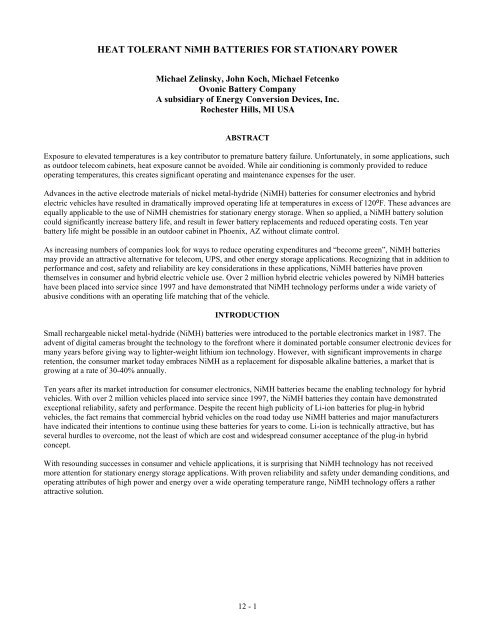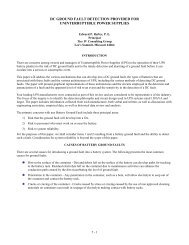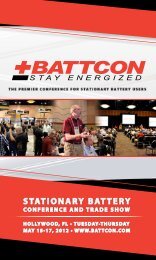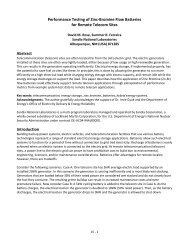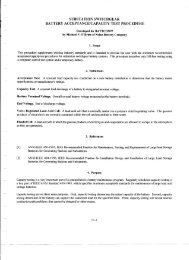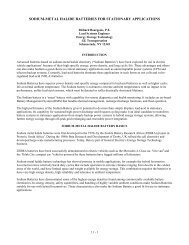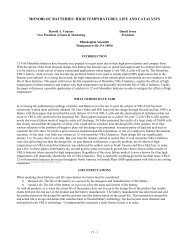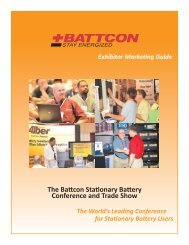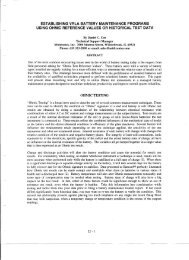HEAT TOLERANT NiMH BATTERIES FOR STATIONARY POWER
HEAT TOLERANT NiMH BATTERIES FOR STATIONARY POWER
HEAT TOLERANT NiMH BATTERIES FOR STATIONARY POWER
Create successful ePaper yourself
Turn your PDF publications into a flip-book with our unique Google optimized e-Paper software.
<strong>HEAT</strong> <strong>TOLERANT</strong> <strong>NiMH</strong> <strong>BATTERIES</strong> <strong>FOR</strong> <strong>STATIONARY</strong> <strong>POWER</strong><br />
Michael Zelinsky, John Koch, Michael Fetcenko<br />
Ovonic Battery Company<br />
A subsidiary of Energy Conversion Devices, Inc.<br />
Rochester Hills, MI USA<br />
ABSTRACT<br />
Exposure to elevated temperatures is a key contributor to premature battery failure. Unfortunately, in some applications, such<br />
as outdoor telecom cabinets, heat exposure cannot be avoided. While air conditioning is commonly provided to reduce<br />
operating temperatures, this creates significant operating and maintenance expenses for the user.<br />
Advances in the active electrode materials of nickel metal-hydride (<strong>NiMH</strong>) batteries for consumer electronics and hybrid<br />
electric vehicles have resulted in dramatically improved operating life at temperatures in excess of 120⁰F. These advances are<br />
equally applicable to the use of <strong>NiMH</strong> chemistries for stationary energy storage. When so applied, a <strong>NiMH</strong> battery solution<br />
could significantly increase battery life, and result in fewer battery replacements and reduced operating costs. Ten year<br />
battery life might be possible in an outdoor cabinet in Phoenix, AZ without climate control.<br />
As increasing numbers of companies look for ways to reduce operating expenditures and “become green”, <strong>NiMH</strong> batteries<br />
may provide an attractive alternative for telecom, UPS, and other energy storage applications. Recognizing that in addition to<br />
performance and cost, safety and reliability are key considerations in these applications, <strong>NiMH</strong> batteries have proven<br />
themselves in consumer and hybrid electric vehicle use. Over 2 million hybrid electric vehicles powered by <strong>NiMH</strong> batteries<br />
have been placed into service since 1997 and have demonstrated that <strong>NiMH</strong> technology performs under a wide variety of<br />
abusive conditions with an operating life matching that of the vehicle.<br />
INTRODUCTION<br />
Small rechargeable nickel metal-hydride (<strong>NiMH</strong>) batteries were introduced to the portable electronics market in 1987. The<br />
advent of digital cameras brought the technology to the forefront where it dominated portable consumer electronic devices for<br />
many years before giving way to lighter-weight lithium ion technology. However, with significant improvements in charge<br />
retention, the consumer market today embraces <strong>NiMH</strong> as a replacement for disposable alkaline batteries, a market that is<br />
growing at a rate of 30-40% annually.<br />
Ten years after its market introduction for consumer electronics, <strong>NiMH</strong> batteries became the enabling technology for hybrid<br />
vehicles. With over 2 million vehicles placed into service since 1997, the <strong>NiMH</strong> batteries they contain have demonstrated<br />
exceptional reliability, safety and performance. Despite the recent high publicity of Li-ion batteries for plug-in hybrid<br />
vehicles, the fact remains that commercial hybrid vehicles on the road today use <strong>NiMH</strong> batteries and major manufacturers<br />
have indicated their intentions to continue using these batteries for years to come. Li-ion is technically attractive, but has<br />
several hurdles to overcome, not the least of which are cost and widespread consumer acceptance of the plug-in hybrid<br />
concept.<br />
With resounding successes in consumer and vehicle applications, it is surprising that <strong>NiMH</strong> technology has not received<br />
more attention for stationary energy storage applications. With proven reliability and safety under demanding conditions, and<br />
operating attributes of high power and energy over a wide operating temperature range, <strong>NiMH</strong> technology offers a rather<br />
attractive solution.<br />
12 - 1
TECHNOLOGY<br />
A basic <strong>NiMH</strong> cell consists of a metal hydride (MH) anode and a nickel hydroxide cathode in a high conductivity aqueous<br />
potassium hydroxide electrolyte. This chemistry provides a cell potential of 1.2V with an overall discharge reaction which<br />
can be written:<br />
MH + NiOOH M + Ni(OH)2<br />
Where nickel oxyhydroxide is reduced to nickel hydroxide and metal hydride (MH) is oxidized to a metal alloy (M). This<br />
process is reversed during charging. The electrolyte is not consumed in the overall chemical reaction thereby maintaining a<br />
consistent concentration to provide high power and long cycle life.<br />
Adjusting the negative to positive (N/P) ratio to provide excess MH negative electrode capacity enhances the cell’s gas<br />
recombination mechanism to prevent build-up of gasses during overcharge (oxygen recombination) or over-discharge<br />
(hydrogen recombination) situations. This additional capacity also helps to inhibit oxidation or corrosion of the MH alloy.<br />
Cell construction<br />
<strong>NiMH</strong> batteries are constructed in a variety of shapes and sizes, from small<br />
button cells to standard cylindrical sizes to large format prismatic cells up to<br />
250 Ah capacity. Whereas smaller cells routinely use the cell case as an<br />
electrical contact, prismatic cells like that shown in figure 1 utilize individual<br />
terminals which are electrically insulated from the welded lid/case assembly.<br />
The lid also features a re-sealable safety vent.<br />
Technology improvements<br />
Since its market introduction, <strong>NiMH</strong> technology has undergone continuous<br />
improvement and further development, typically following paths specific to<br />
different application requirements such as high power, high energy density,<br />
high cycle life, and other characteristics.<br />
Early consumer <strong>NiMH</strong> AA cells demonstrated a specific energy of 54<br />
Wh/kg. Improvements in electrode materials and manufacturing methods<br />
have more than doubled this value as shown in Figure 2.<br />
Figure 1: Prismatic <strong>NiMH</strong><br />
cell construction<br />
Figure 2: <strong>NiMH</strong> AA cell evolution<br />
Specific energy is reduced somewhat in batteries with enhanced current collectors and other features designed for high power<br />
applications. 45-60 Wh/kg specific energy is normal for hybrid vehicle batteries whose specific power can exceed 1300 W/kg<br />
under both charge and discharge conditions. Traditionally, <strong>NiMH</strong> was considered a low power technology, but some<br />
12 - 2
Cycles<br />
manufacturers have demonstrated specific power as high as 2000 W/kg. Figure 3 shows that improved C cells can easily<br />
discharge at 10-C rates.<br />
Figure 3: <strong>NiMH</strong> C cells discharge performance<br />
Improvements in charge retention are primarily responsible for today’s increased use of consumer <strong>NiMH</strong> batteries as<br />
replacements for disposable alkaline cells. Early <strong>NiMH</strong> products exhibited self discharge rates as high as 70% in one month<br />
at room temperature. Improvements in MH alloys, Ni(OH)2, and separator materials have reduced self discharge in certain<br />
applications to less than 15% per year making it possible to market “ready to use” <strong>NiMH</strong> batteries. With widespread<br />
availability and comparable purchase price to alkaline cells, consumers are switching to rechargeable <strong>NiMH</strong> in increasing<br />
numbers.<br />
Consumer <strong>NiMH</strong> batteries vary by manufacturer, but typically provide 500 to 1000 full discharge cycles making their<br />
lifecycle costs a tremendous value compared to disposable alkaline batteries. Many factors can influence cycle life in larger<br />
format <strong>NiMH</strong> cells; substrates, active material formulations, material processing (structure), electrode construction, etc. Cell<br />
balance and depth of discharge can influence cycle life of most battery chemistries. Figure 4 shows that <strong>NiMH</strong> batteries<br />
demonstrate exceptional cycle life at all discharge depths.<br />
1000000<br />
100000<br />
10000<br />
1000<br />
100<br />
10<br />
1<br />
100<br />
90<br />
80<br />
70 60 50 40<br />
Depth of Discharge (%)<br />
30<br />
20<br />
10<br />
0<br />
Figure 4: <strong>NiMH</strong> cycle life vs. discharge depth<br />
Operation over a wide temperature range is a problem for all batteries and prolonged exposure to elevated temperatures can<br />
be particularly troublesome. Early <strong>NiMH</strong> batteries intended for electric vehicle use would lose almost 50% of their room<br />
temperature capacity when charged at 60⁰C. Advancements in nickel hydroxide active materials have overcome this problem<br />
and have pushed the temperature limit even further as shown in Figure 5.<br />
12 - 3
300<br />
250<br />
Power (W/kg)<br />
200<br />
150<br />
100<br />
50<br />
Standard<br />
Ni(OH) 2<br />
Ovonic GreenLife<br />
Ni(OH) 2<br />
0<br />
0 200 400 600 800 1000<br />
Cycles<br />
Figure 5: 70⁰C EV battery improvement<br />
If all of these improvements (energy, power, charge retention, cycle life, and high temperature resistance) could be taken<br />
collectively into a single design, the resulting battery would represent an extremely attractive solution for current and<br />
emerging stationary power applications.<br />
<strong>STATIONARY</strong> APPLICATIONS<br />
The concept of utilizing <strong>NiMH</strong> batteries for stationary applications was introduced at Battcon 2005. At that time, a value<br />
proposition of reduced weight and size compared to lead acid was proposed. A case study of a 560kW UPS battery<br />
replacement showed an incredible 68% floor space reduction achieved by replacing a room full of flooded lead acid batteries<br />
with stacks of <strong>NiMH</strong> modules. 1 While this is one important benefit of <strong>NiMH</strong>, the technology brings a host of persuasively<br />
beneficial attributes for stationary customers.<br />
Consider the telecommunications market. As power systems have become further distributed, more and more equipment is<br />
installed in outdoor enclosures. These enclosures are typically exposed to wide temperature fluctuations where prolonged<br />
exposure to elevated temperature which can severely shorten the life of VRLA batteries. Some users have installed air<br />
conditioning systems to maintain appropriate temperatures to extend battery life, but this practice can subject the customer to<br />
substantial operating and maintenance expenses. Some battery manufacturers have begun marketing advanced NiCd and Liion<br />
batteries as higher temperature solutions allowing for warmer operating conditions while preserving battery life. 2<br />
However, as shown in the graph in Figure 6, these “advanced solutions” pale in comparison to the inherent temperature<br />
capability of <strong>NiMH</strong> technology. With the ability to operate at temperatures as high as 70⁰C (158⁰F), <strong>NiMH</strong> batteries can<br />
eliminate the need for expensive temperature controlling systems. We see the existing telecom outside plant application as an<br />
immediate, ideal fit for <strong>NiMH</strong> technology. Similarly, the high temperature capability of <strong>NiMH</strong> batteries could allow central<br />
office, data center, and server room operators to reduce their operating costs by<br />
slashing climate control expenses.<br />
Looking forward, significant attention is being focused on the emerging “smart grid”<br />
where utility-scale storage will be required to balance supply of power generated<br />
from intermittent renewable sources along with fluctuating demand created by large<br />
numbers of customers potentially charging plug-in hybrid vehicles. According to<br />
GTM Research, storing electricity on the grid could become a $2.5B market by 2015.<br />
Utilities see energy storage as a means to utilize the existing infrastructure more<br />
efficiently through balancing supply and demand peaks. In order to operate in a cost<br />
effective manner, such grid storage systems will require extensive cycle life with<br />
very high round-trip efficiency. <strong>NiMH</strong> battery solutions have demonstrated<br />
efficiencies greater than 95% with exceptional cycle life as illustrated previously in<br />
Figure 4.<br />
Figure 6: Maximum temperature<br />
by battery chemistry<br />
12 - 4
Competitive position<br />
Table 1 summarizes the advantages and disadvantages of <strong>NiMH</strong> batteries compared to other stationary battery chemistries.<br />
Table 1: Advantages and disadvantages of <strong>NiMH</strong> battery technology<br />
Advantages of <strong>NiMH</strong><br />
-Higher energy density than VRLA and NiCd<br />
-Higher temperature capability than VRLA, NiCd and<br />
Li-ion<br />
-Excellent charge retention<br />
Good high rate capability<br />
-Longer cycle life at higher DOD than VRLA<br />
-Proven safety and reliability in demanding HEV<br />
application<br />
Disadvantages of <strong>NiMH</strong><br />
-Higher initial cost than VRLA<br />
-Lower gravimetric energy density and specific power<br />
compared to Li-ion<br />
-No available product for stationary applications<br />
-Certifications will delay market introduction<br />
Cost Challenge<br />
The advantages outlined in Table 1 attest to the attractiveness of <strong>NiMH</strong> technology, but cost represents the most significant<br />
factor in determining market success. Large prismatic <strong>NiMH</strong> cells for hybrid vehicles are commercially available for $800-<br />
1000 / kWh. However, many features of the high power HEV battery are not required for use in stationary applications. The<br />
removal of unnecessary features provides an opportunity to reduce cost by 50% or more, in volume. While this would still<br />
translate to about double the cost of incumbent VRLA batteries, the performance attributes of <strong>NiMH</strong> technology suggests a<br />
rather impressive lifecycle cost savings to the user.<br />
Consider a typical air conditioned outdoor telecom enclosure with 2 strings of 12V, 100Ah VRLA batteries. Given initial<br />
purchase price, maintenance and replacement after approximately 7 years, the effective battery cost to the customer over 10<br />
years is approximately $14,600 plus the cost of electricity to maintain temperature below 77⁰F. NiCd batteries are reported to<br />
last 10 years at 35⁰C (95⁰F) eliminating replacement and reducing climate control cost. 3 If battery purchase price is reduced<br />
by these operating cost savings, the effective cost to the customer of such NiCd batteries over 10 years is reduced by more<br />
than half. A similar model can be applied to Li-ion batteries, although initial cost will be higher and operating life remains to<br />
be proven. In contrast, a <strong>NiMH</strong> battery solution could further reduce operating expenses by allowing the customer to<br />
maintain a temperature as high as 45⁰C (113⁰F), the operating temperature of the electronic equipment. 4 Over the 10 year life<br />
of the battery 5 , the savings in operating expenses would significantly offset the projected $400/kWh purchase price creating<br />
an effective 10-year cost to the customer less than one-fifth that of VRLA. This 10-year lifecycle cost comparison is<br />
illustrated in Figure 7 below.<br />
Effective cost<br />
$16,000<br />
$14,000<br />
$12,000<br />
$10,000<br />
$8,000<br />
$6,000<br />
$4,000<br />
$2,000<br />
$0<br />
10 Year Lifecycle Cost Analysis for a<br />
9.6kWh Telecom OSP Installation<br />
VRLA NiCd Li-ion <strong>NiMH</strong><br />
Figure 7: 10-year battery cost comparison<br />
12 - 5
CONCLUSION<br />
Although nickel metal hydride batteries were introduced to the market more than 20 years ago, the technology is far from<br />
mature as evidenced by the wide range of performance improvements that have been achieved and further advancements<br />
being made through ongoing R&D. High energy density, exceptional high temperature capability, long cycle life, excellent<br />
charge retention and high efficiency, combined with proven safety and reliability in demanding consumer and hybrid vehicle<br />
applications make <strong>NiMH</strong> technology an excellent candidate for stationary power applications.<br />
REFERENCES<br />
1. Kopera, J, “Considerations For The Utilization of <strong>NiMH</strong> Battery Technology in Stationary Applications”, Battcon 2005<br />
Proceedings, 2005.<br />
2. McDowall, J, “Energy-Saving Batteries – Green or Greenwash?”, Battcon 2009 Proceedings, 2009.<br />
3. Brenier, A, The Contribution of Battery Technology and Thermal Management to Energy-efficient Broadband Telecom<br />
Networks”, OSP Expo 2009.<br />
4. Telcordia Technologies GR-487-CORE “Electonic Equipment Cabinets”.<br />
5. Telcordia Technologies DA-1065 “Accelerated Life Testing of the Cobasys Ni-metal Hydride Battery Operated at<br />
Moderate and High Temperatures”, 2008.<br />
12 - 6


